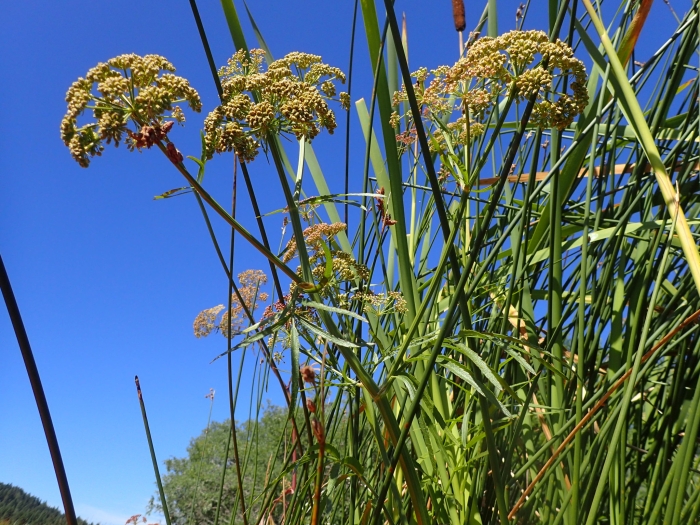Hemlock Waterparsnip
(Sium suave)
Hemlock Waterparsnip (Sium suave)
/
/

mfeaver
CC BY 4.0
Image By:
mfeaver
Recorded By:
Copyright:
CC BY 4.0
Copyright Notice:
Photo by: mfeaver | License Type: CC BY 4.0 | License URL: http://creativecommons.org/licenses/by/4.0/ | Rights Holder: mfeaver | Publisher: iNaturalist | Date Created: 2019-08-27T13:01:29-07:00 |
















































Estimated Native Range
Summary
Sium suave, commonly known as Hemlock Waterparsnip, is a semi-deciduous perennial herb native to wetland habitats such as marshes, swamps, and along the edges of ponds and streams in North America, East Asia, and Siberia. It typically grows up to 3 meters tall with stems that are 5 cm in diameter. The stems of Hemlock Waterparsnip are light green, glabrous, with longitudinal veins, and have few branches. Its flowers are perfect, meaning they contain both male and female reproductive parts, and are self-fertile. The inflorescence is an umbel with 10-20 small white flowers, each about 3.2 mm across, with heart-shaped petals that may vary in size. Flowering occurs from July to August, and seeds ripen from September to October.
Hemlock Waterparsnip is valued for its ability to thrive in wetland areas, providing ecological benefits such as habitat for wildlife and contributing to water purification. It is used in naturalistic plantings and as part of water garden designs. The plant prefers wet, mucky soil or sand and can grow in standing water up to an inch and a half deep. It is adaptable to partial or full sun exposure. Seeds should be sown in late winter to early spring in a cold frame. While it is not known for significant pest or disease problems, care should be taken to avoid overly dry conditions which can stress the plant.CC BY-SA 4.0
Hemlock Waterparsnip is valued for its ability to thrive in wetland areas, providing ecological benefits such as habitat for wildlife and contributing to water purification. It is used in naturalistic plantings and as part of water garden designs. The plant prefers wet, mucky soil or sand and can grow in standing water up to an inch and a half deep. It is adaptable to partial or full sun exposure. Seeds should be sown in late winter to early spring in a cold frame. While it is not known for significant pest or disease problems, care should be taken to avoid overly dry conditions which can stress the plant.CC BY-SA 4.0
Plant Description
- Plant Type: Herb
- Height: 2-6 feet
- Width: 2-3 feet
- Growth Rate: Rapid
- Flower Color: White
- Flowering Season: Summer, Fall
- Leaf Retention: Deciduous
Growth Requirements
- Sun: Full Sun, Part Shade
- Water: Medium, High
- Drainage: Standing, Medium, Fast
Common Uses
Bee Garden, Bird Garden, Edible*Disclaimer: Easyscape's listed plant edibility is for informational use. Always verify the safety and proper identification of any plant before consumption., Water Garden
Natural Habitat
Wetland habitats such as marshes, swamps, and pond and stream edges
Other Names
Common Names: Water-Parsley, Water-Parsnip, Sium Suave, Hemlock Water-Parsnip, Common Water-Parsnip, Fragrant Water-Parsnip, Berle Douce, Berle Suave, 개발나물, 細葉零餘子, Common Waterparsnip
Scientific Names: , Sium suave, Sium cicutaefolium, Sium cicutifolium, Sium suave var. nipponicum, Sium carsonii, Sium suave subsp. nipponicum, Sium lineare, Sium nipponicum, Sium floridanum
GBIF Accepted Name: Sium suave Walter